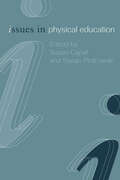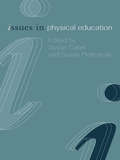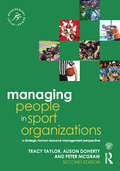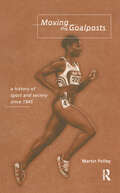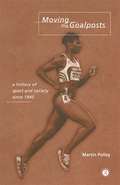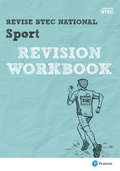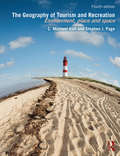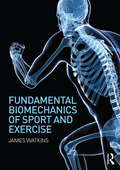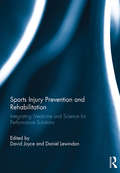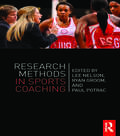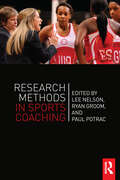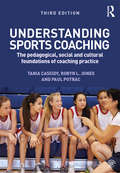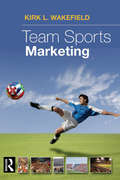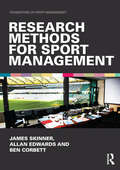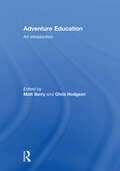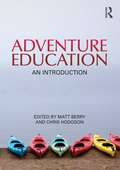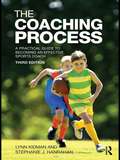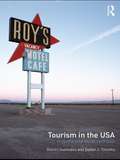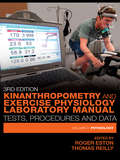- Table View
- List View
Issues in Physical Education
by Susan Capel Susan PiotrowskiIssues in Physical Education stimulates student-teachers, NQTs and practising physical education teachers to reflect on issues important to improving teaching in physical education. It encourages reflection and debate as an important part of professional development. Issues discussed include: aims as an issue in physical education breadth, balance and assessment in the physical education curriculum equality and the inclusion of pupils with special needs in physical education progression and continuity in physical education between primary and secondary schools community initiatives in physical education physical education, health and life-long participation in physical activity.
Issues in Physical Education
by Susan Capel Susan PiotrowskiIssues in Physical Education stimulates student-teachers, NQTs and practising physical education teachers to reflect on issues important to improving teaching in physical education. It encourages reflection and debate as an important part of professional development. Issues discussed include: aims as an issue in physical education breadth, balance and assessment in the physical education curriculum equality and the inclusion of pupils with special needs in physical education progression and continuity in physical education between primary and secondary schools community initiatives in physical education physical education, health and life-long participation in physical activity.
Managing People in Sport Organizations: A Strategic Human Resource Management Perspective (Sport Management Series)
by Tracy Taylor Alison Doherty Peter McGrawManaging People in Sport Organizations provides a comprehensive overview of the theory and practice of managing people within a strategic framework. This revised and updated second edition examines a range of strategic human resource management approaches that can be used by sport organizations to respond to contemporary challenges and to develop a sustainable performance culture. Drawing on well-established conceptual frameworks and current empirical research, the book systematically covers every key area of HRM theory and practice, including: recruitment training and development performance management and appraisal motivation and reward organizational culture employee relations diversity managing change This new edition also includes expanded coverage of social media, volunteers, and individuals within organizations, and is supported with a new companion website carrying additional resources for students and instructors, including PowerPoint slides, exam questions and useful web links. No other book offers such an up-to-date introduction to core concepts and key professional skills in HRM in sport, and therefore?Managing People in Sport Organizations?is essential reading for any sport management student or any HR professional working in sport.
Moving the Goalposts: A History of Sport and Society in Britain since 1945
by Martin PolleyMartin Polley provides a survey of sport in Britain since 1945 and examines sport's place in British culture. He discusses issues of class, gender, race, commerce and politics, as well as analysing contemporary sport.
Moving the Goalposts: A History of Sport and Society in Britain since 1945
by Martin PolleyMartin Polley provides a survey of sport in Britain since 1945 and examines sport's place in British culture. He discusses issues of class, gender, race, commerce and politics, as well as analysing contemporary sport.
Revise BTEC National Sport: Revision Workbook (PDF)
by Sue Hartigan Kelly SharpUpdates to BTEC National Set Tasks for external assessment - April 2017As a result of feedback from the Department for Education Pearson have made updates to the Set Tasks for some BTEC National qualifications. Therefore subsequent changes have been made to this product. If you have purchased this book before 13th April 2017, details of these changes can be found here. [link to www. pearsonfe. co. uk/BTECchanges]. Corrected copies will be available to purchase by June 2017. Exam Board: Pearson EdexcelAcademic Level: BTEC NationalSubject: SportFirst teaching: September 2016First Exams: Summer 2017 For all four of the externally assessed units 1 and 2. Builds confidence with scaffolded practice questions. Unguided questions that allow students to test their own knowledge and skills in advance of assessment. Clear unit-by-unit correspondence between this Workbook and the Revision Guide and ActiveBook.
The Geography of Tourism and Recreation: Environment, Place and Space
by C. Michael Hall Stephen J. PageThis fourth edition of The Geography of Tourism and Recreation provides students with a comprehensive introduction to the interrelationship between tourism, leisure and recreation from geographical and social science perspectives. It still remains the only book to systematically compare and contrast in a spatial context, tourism and recreation in relation to leisure time, offering insight into the demand, supply, planning, destination management and impacts of tourism and recreation.Whilst retaining its accessible style and approach this edition has been significantly updated to reflect recent developments and new concepts from geography which are beginning to permeate the tourism and recreational field. New features include: Content on the most recent developments, climate change, sustainability, mobilities and crisis management in time and space as well as trends such as low cost airlines and the control of land transport by transnational operators in the EU such as Arriva. More attention to management issues such as innovation and the spatial consequences for tourism and leisure development. New case studies and examples to showcase real life issues, from both developed and developing countries, especially the US, China and South Africa. Completely revised and redeveloped to accommodate new, user- friendly features: case studies, insights, summary points and learning objectives. Written by leading academics, this is essential reading for all tourism, geography, leisure and recreation students.
The Geography of Tourism and Recreation: Environment, Place and Space
by C. Michael Hall Stephen J. PageThis fourth edition of The Geography of Tourism and Recreation provides students with a comprehensive introduction to the interrelationship between tourism, leisure and recreation from geographical and social science perspectives. It still remains the only book to systematically compare and contrast in a spatial context, tourism and recreation in relation to leisure time, offering insight into the demand, supply, planning, destination management and impacts of tourism and recreation.Whilst retaining its accessible style and approach this edition has been significantly updated to reflect recent developments and new concepts from geography which are beginning to permeate the tourism and recreational field. New features include: Content on the most recent developments, climate change, sustainability, mobilities and crisis management in time and space as well as trends such as low cost airlines and the control of land transport by transnational operators in the EU such as Arriva. More attention to management issues such as innovation and the spatial consequences for tourism and leisure development. New case studies and examples to showcase real life issues, from both developed and developing countries, especially the US, China and South Africa. Completely revised and redeveloped to accommodate new, user- friendly features: case studies, insights, summary points and learning objectives. Written by leading academics, this is essential reading for all tourism, geography, leisure and recreation students.
Fundamental Biomechanics of Sport and Exercise
by James WatkinsFundamental Biomechanics of Sport and Exercise is an engaging and comprehensive introductory textbook that explains biomechanical concepts from first principles, showing clearly how the science relates to real sport and exercise situations. The book is divided into two parts. The first provides a clear and detailed introduction to the structure and function of the human musculoskeletal system and its structural adaptations, essential for a thorough understanding of human movement. The second part focuses on the biomechanics of movement, describing the forces that act on the human body and the effects of those forces on the movement of the body. Every chapter includes numerous applied examples from sport and exercise, helping the student to understand how mechanical concepts describe both simple and complex movements, from running and jumping to pole-vaulting or kicking a football. In addition, innovative worksheets for field and laboratory work are included that contain clear objectives, a description of method, data recording sheets, plus a set of exemplary data and worked analysis. Alongside these useful features are definitions of key terms plus review questions to aid student learning, with detailed solutions provided for all numerical questions. No other textbook offers such a clear, easy-to-understand introduction to the fundamentals of biomechanics. This is an essential textbook for any biomechanics course taken as part of degree programme in sport and exercise science, kinesiology, physical therapy, sports coaching or athletic training.
Fundamental Biomechanics of Sport and Exercise
by James WatkinsFundamental Biomechanics of Sport and Exercise is an engaging and comprehensive introductory textbook that explains biomechanical concepts from first principles, showing clearly how the science relates to real sport and exercise situations. The book is divided into two parts. The first provides a clear and detailed introduction to the structure and function of the human musculoskeletal system and its structural adaptations, essential for a thorough understanding of human movement. The second part focuses on the biomechanics of movement, describing the forces that act on the human body and the effects of those forces on the movement of the body. Every chapter includes numerous applied examples from sport and exercise, helping the student to understand how mechanical concepts describe both simple and complex movements, from running and jumping to pole-vaulting or kicking a football. In addition, innovative worksheets for field and laboratory work are included that contain clear objectives, a description of method, data recording sheets, plus a set of exemplary data and worked analysis. Alongside these useful features are definitions of key terms plus review questions to aid student learning, with detailed solutions provided for all numerical questions. No other textbook offers such a clear, easy-to-understand introduction to the fundamentals of biomechanics. This is an essential textbook for any biomechanics course taken as part of degree programme in sport and exercise science, kinesiology, physical therapy, sports coaching or athletic training.
Sports Injury Prevention and Rehabilitation: Integrating Medicine and Science for Performance Solutions
by David Joyce Daniel LewindonWorld-class rehabilitation of the injured athlete integrates best practice in sports medicine and physical therapy with training and conditioning techniques based on cutting-edge sports science. In this ground-breaking new book, leading sports injury and rehabilitation professionals, strength and conditioning coaches, biomechanists and sport scientists show how this integrated model works across the spectrum of athlete care. In every chapter, there is a sharp focus on the return to performance, rather than just a return to play. The book introduces evidence-based best practice in all the core areas of sports injury risk management and rehabilitation, including: performance frameworks for medical and injury screening; the science of pain and the psychology of injury and rehabilitation; developing core stability and flexibility; performance retraining of muscle, tendon and bone injuries; recovery from training and rehabilitation; end-stage rehabilitation, testing and training for a return to performance. Every chapter offers a masterclass from a range of elite sport professionals, containing best practice protocols, procedures and specimen programmes designed for high performance. No other book examines rehabilitation in such detail from a high performance standpoint. Sports Injury Prevention and Rehabilitation is essential reading for any course in sports medicine and rehabilitation, strength and conditioning, sports science, and for any clinician, coach or high performance professional working to prevent or rehabilitate sports injuries.
Research Methods in Sports Coaching
by Lee Nelson Ryan Groom Paul PotracResearch Methods in Sports Coaching is a key resource for any student, researcher or practitioner wishing to undertake research into sports coaching. It takes the reader through each phase of the research process, from identifying valuable research questions, to data collection and analyses, to the presentation and dissemination of research findings. It is the only book to focus on the particular challenges and techniques of sports coaching research, with each chapter including examples, cases and scenarios from the real world of sports coaching. The book introduces and explores important philosophical, theoretical and practical considerations in conducting coaching research, including contextual discussions about why it’s important to do sports coaching research, how to judge the quality of coaching research, and how sports coaching research might meet the needs of coaching practitioners. Written by a team of leading international scholars and researchers from the UK, US, Canada and Australia, and bridging the gap between theory and practice, this book is an essential course text for any research methods course taken as part of a degree programme in sports coaching or coach education.
Research Methods in Sports Coaching
by Lee Nelson Ryan Groom Paul PotracResearch Methods in Sports Coaching is a key resource for any student, researcher or practitioner wishing to undertake research into sports coaching. It takes the reader through each phase of the research process, from identifying valuable research questions, to data collection and analyses, to the presentation and dissemination of research findings. It is the only book to focus on the particular challenges and techniques of sports coaching research, with each chapter including examples, cases and scenarios from the real world of sports coaching. The book introduces and explores important philosophical, theoretical and practical considerations in conducting coaching research, including contextual discussions about why it’s important to do sports coaching research, how to judge the quality of coaching research, and how sports coaching research might meet the needs of coaching practitioners. Written by a team of leading international scholars and researchers from the UK, US, Canada and Australia, and bridging the gap between theory and practice, this book is an essential course text for any research methods course taken as part of a degree programme in sports coaching or coach education.
Understanding Sports Coaching: The Pedagogical, Social and Cultural Foundations of Coaching Practice
by Tania G. Cassidy Robyn L. Jones Paul A. PotracEvery successful sports coach knows that good teaching and social practices are just as important as expertise in sport skills and tactics. Now in a fully revised and updated third edition, Understanding Sports Coaching is still the only introduction to theory and practice in sports coaching to fully explore the social, cultural and pedagogical concepts underpinning good coaching practice. The book examines the complex interplay between coach, athlete, coaching programme and social context, and encourages coaches to develop an open and reflective approach to their own coaching practice. It covers every key aspect of coaching theory and practice, including important and emerging topics, such as: athletes’ identities athlete learning emotion in coaching coaching ethics professionalization talent identification and development coaching as a (micro)political activity Understanding Sports Coaching also includes a full range of practical exercises and extended case studies designed to encourage coaches to reflect critically upon their own coaching strategies, their interpersonal skills and upon important issues in contemporary sports coaching. This is an essential textbook for any degree-level course in sports coaching, and for any professional coach looking to develop their coaching expertise.
Team Sports Marketing
by Kirk WakelandSome might argue that sports marketing is a mere subfield of marketing, meaning that there are theoretical and practical dimensions that apply only to sports marketing and are only of interest to those involved in sports. In Team Sports Marketing, author Kirk Wakefield dispels this argument by demonstrating that effective sports marketing epitomizes the science and art of marketing across any context. At the core of sports marketing is the creation and enhancement of fan identification, where consumers are not just loyal customers, but have become brand fanatics.Team Sports Marketing shows that while many aspects of sports marketing are thought to be unique to the field, other product and service sectors would do well to learn from teams in the NFL, NBA, MLB, and NHL that have transformed customers into fans. Moving beyond principles of marketing, Team Sports Marketing is packed with examples of best practices and covering subjects as diverse as sponsorships, season ticket sales, venue management and all topics in between. Team Sports Marketing is a must read text for students and managers in professional and collegiate sports. Support materials for professors and students are available at www.teamsportsmarketing.com.
Team Sports Marketing
by Kirk WakelandSome might argue that sports marketing is a mere subfield of marketing, meaning that there are theoretical and practical dimensions that apply only to sports marketing and are only of interest to those involved in sports. In Team Sports Marketing, author Kirk Wakefield dispels this argument by demonstrating that effective sports marketing epitomizes the science and art of marketing across any context. At the core of sports marketing is the creation and enhancement of fan identification, where consumers are not just loyal customers, but have become brand fanatics.Team Sports Marketing shows that while many aspects of sports marketing are thought to be unique to the field, other product and service sectors would do well to learn from teams in the NFL, NBA, MLB, and NHL that have transformed customers into fans. Moving beyond principles of marketing, Team Sports Marketing is packed with examples of best practices and covering subjects as diverse as sponsorships, season ticket sales, venue management and all topics in between. Team Sports Marketing is a must read text for students and managers in professional and collegiate sports. Support materials for professors and students are available at www.teamsportsmarketing.com.
Research Methods for Sport Management
by James Skinner Allan Edwards Ben CorbettResearch methods courses have become a compulsory component of most degree programs in sport management. This is the first introductory research methods textbook to focus exclusively on sport management. Through the use of examples, cases and data taken from the real world of sport management it opens up a traditionally dry area of study, helping the student to understand the vital importance of sound methodology in their studies and subsequent professional practice. The book covers the full range of quantitative and qualitative methods across the whole span of the research process, from research design and the literature review to data analysis and report writing. Every chapter contains a range of useful features to aid student learning, including summaries, discussion questions and guides to further resources, as well as examples drawn from contemporary sport around the world. Research Methods for Sport Management is an essential course text for all sport management students and an invaluable reference for any sport management professional involved in operational research.
Research Methods for Sport Management
by James Skinner Allan Edwards Ben CorbettResearch methods courses have become a compulsory component of most degree programs in sport management. This is the first introductory research methods textbook to focus exclusively on sport management. Through the use of examples, cases and data taken from the real world of sport management it opens up a traditionally dry area of study, helping the student to understand the vital importance of sound methodology in their studies and subsequent professional practice. The book covers the full range of quantitative and qualitative methods across the whole span of the research process, from research design and the literature review to data analysis and report writing. Every chapter contains a range of useful features to aid student learning, including summaries, discussion questions and guides to further resources, as well as examples drawn from contemporary sport around the world. Research Methods for Sport Management is an essential course text for all sport management students and an invaluable reference for any sport management professional involved in operational research.
Adventure Education: An Introduction
by Chris Hodgson Matt BerryAdventure Education is a form of experiential learning typically associated with activities involving risk, from cooperative games such as raft building to high adventure activities such as rock climbing. Adventure Education: An Introduction provides a comprehensive introduction to the planning, delivery and evaluation of Adventure Education, with a strong emphasis on professional practice and delivery. Written by a team of leading Adventure Educators who can draw upon an extensive experience base, the book explores the most important strategies for teaching, learning and implementation in Adventure Education. The book is fully illustrated throughout with real-world case studies and research surveying the key contemporary issues facing Adventure Education Practitioners. This includes essentials for the adventure educator such as risk management and tailoring activities to meet specific learning needs, as well as providing an insight into contemporary uses for adventure programmes. With outdoor and adventure activities being more popular than ever before, this book is essential reading for any student, teacher or practitioner looking to understand Adventure Education and develop their professional skills.
Adventure Education: An Introduction
by Chris Hodgson Matt BerryAdventure Education is a form of experiential learning typically associated with activities involving risk, from cooperative games such as raft building to high adventure activities such as rock climbing. Adventure Education: An Introduction provides a comprehensive introduction to the planning, delivery and evaluation of Adventure Education, with a strong emphasis on professional practice and delivery. Written by a team of leading Adventure Educators who can draw upon an extensive experience base, the book explores the most important strategies for teaching, learning and implementation in Adventure Education. The book is fully illustrated throughout with real-world case studies and research surveying the key contemporary issues facing Adventure Education Practitioners. This includes essentials for the adventure educator such as risk management and tailoring activities to meet specific learning needs, as well as providing an insight into contemporary uses for adventure programmes. With outdoor and adventure activities being more popular than ever before, this book is essential reading for any student, teacher or practitioner looking to understand Adventure Education and develop their professional skills.
The Coaching Process: A Practical Guide to Becoming an Effective Sports Coach
by Lynn Kidman Stephanie J. HanrahanIn this fresh and engaging introduction to sports coaching, Lynn Kidman and Stephanie Hanrahan guide students through the coaching process. Focusing on the practical aspects of sports coaching, the book helps students to develop their basic technical skills as well as strategies for working with individual and team athletes, and to plan and implement effective coaching sessions. The book develops an "athlete-centred approach" to sports coaching, by which athletes take ownership of their learning, in turn strengthening their abilities to retain key skills and to make effective decisions during competition. Useful pedagogical features in each chapter, such as real life case studies, activities, self-reflection questions, and summaries of current research and best practice, encourage reflective practice and help student coaches to develop and extend their coaching techniques and philosophies. The Coaching Process is invaluable reading for any student starting a sports coaching course at college or university, and for any coach working with athletes or children in sport who wants to improve their practical skills.
The Coaching Process: A Practical Guide to Becoming an Effective Sports Coach
by Lynn Kidman Stephanie J. HanrahanIn this fresh and engaging introduction to sports coaching, Lynn Kidman and Stephanie Hanrahan guide students through the coaching process. Focusing on the practical aspects of sports coaching, the book helps students to develop their basic technical skills as well as strategies for working with individual and team athletes, and to plan and implement effective coaching sessions. The book develops an "athlete-centred approach" to sports coaching, by which athletes take ownership of their learning, in turn strengthening their abilities to retain key skills and to make effective decisions during competition. Useful pedagogical features in each chapter, such as real life case studies, activities, self-reflection questions, and summaries of current research and best practice, encourage reflective practice and help student coaches to develop and extend their coaching techniques and philosophies. The Coaching Process is invaluable reading for any student starting a sports coaching course at college or university, and for any coach working with athletes or children in sport who wants to improve their practical skills.
Tourism in the USA: A Spatial and Social Synthesis
by Dimitri Ioannides Dallen TimothyThe United States continues to provide opportunities for travel and tourism to domestic and international travellers. This is the first book to offer students a comprehensive overview of both tourism and travel in this region, paying specific attention to the disciplines of Geography, Tourism Studies and, more generally, Social Science. Tourism in the USA explains the evolution of tourism paying attention to the forces that shaped the product that exists today. The focus of the book includes the manner in which tourism has played out in various contexts; the role of federal, state, and local policy is also examined in terms of the effects it has had on the US travel industry and on destinations. The various elements of tourism demand and supply are discussed and the influence that transportation (especially Americans’ high personal mobility rates and love affair with the auto) has had on the sector highlighted. The economics of tourism are fleshed out before focusing more narrowly on both the urban and rural settings where tourism occurs. A look into the manner in which the spatial structure of cities is transformed through tourism is also offered. Additionally, a brief examination of future issues in American tourism is presented along with explanations concerning the ascendancy of tourism as an economic development tool in various areas. The book combines theory and practice as well as integrating a range of useful student orientated resources to aid understanding and spur further debate, which can be used for independent study or in class exercises. These include: ‘Closer Look’ case studies with reflective questions to help show theory in practice and encourage critical thinking about tourism developments in this region ‘Discussion Questions’ at the end of each chapter encourage stimulating debates ‘Further Reading’ sections direct the readers to related book and web resources so that they can learn more about the topics covered in each chapter. Written in an engaging style and supported with visual aids, this book will provide students globally with an in-depth and essential understanding of the complexities of tourism and travel in the USA.
Tourism in the USA: A Spatial and Social Synthesis
by Dimitri Ioannides Dallen TimothyThe United States continues to provide opportunities for travel and tourism to domestic and international travellers. This is the first book to offer students a comprehensive overview of both tourism and travel in this region, paying specific attention to the disciplines of Geography, Tourism Studies and, more generally, Social Science. Tourism in the USA explains the evolution of tourism paying attention to the forces that shaped the product that exists today. The focus of the book includes the manner in which tourism has played out in various contexts; the role of federal, state, and local policy is also examined in terms of the effects it has had on the US travel industry and on destinations. The various elements of tourism demand and supply are discussed and the influence that transportation (especially Americans’ high personal mobility rates and love affair with the auto) has had on the sector highlighted. The economics of tourism are fleshed out before focusing more narrowly on both the urban and rural settings where tourism occurs. A look into the manner in which the spatial structure of cities is transformed through tourism is also offered. Additionally, a brief examination of future issues in American tourism is presented along with explanations concerning the ascendancy of tourism as an economic development tool in various areas. The book combines theory and practice as well as integrating a range of useful student orientated resources to aid understanding and spur further debate, which can be used for independent study or in class exercises. These include: ‘Closer Look’ case studies with reflective questions to help show theory in practice and encourage critical thinking about tourism developments in this region ‘Discussion Questions’ at the end of each chapter encourage stimulating debates ‘Further Reading’ sections direct the readers to related book and web resources so that they can learn more about the topics covered in each chapter. Written in an engaging style and supported with visual aids, this book will provide students globally with an in-depth and essential understanding of the complexities of tourism and travel in the USA.
Kinanthropometry and Exercise Physiology Laboratory Manual: Physiology
by Roger Eston Thomas Reilly Tom ReillyKinanthropometry is the study of human body size, shape and form and how those characteristics relate to human movement and sporting performance. In this fully updated and revised edition of the classic guide to kinanthropometric theory and practice, leading international sport and exercise scientists offer a clear and comprehensive introduction to essential principles and techniques. Each chapter guides the reader through the planning and conduct of practical and laboratory sessions and includes a survey of current theory and contemporary literature relating to that topic. The book is fully illustrated and includes worked examples, exercises, research data, chapter summaries and guides to further reading throughout. Volume Two: Exercise Physiology covers key topics such as: neuromuscular aspects of movement skeletal muscle function oxygen transport, including haemotology, pulmonary and cardiovascular functions metabolism and thermoregulation VO2 kinetics physiological economy, efficiency and 'fitness' physiological limitations to performance assessment of energy expenditure, perceived exertion and maximal intensity. The Kinanthropometry and Exercise Physiology Laboratory Manual is essential reading for all serious students and researchers of sport and exercise science, kinesiology and human movement. Roger Eston is Professor of Human Physiology and Head of the School of Sport and Health Sciences at the University of Exeter. Thomas Reilly is Professor of Sports Science and Director of the Research Institute for Sport and Exercise Sciences at Liverpool John Moores University.
